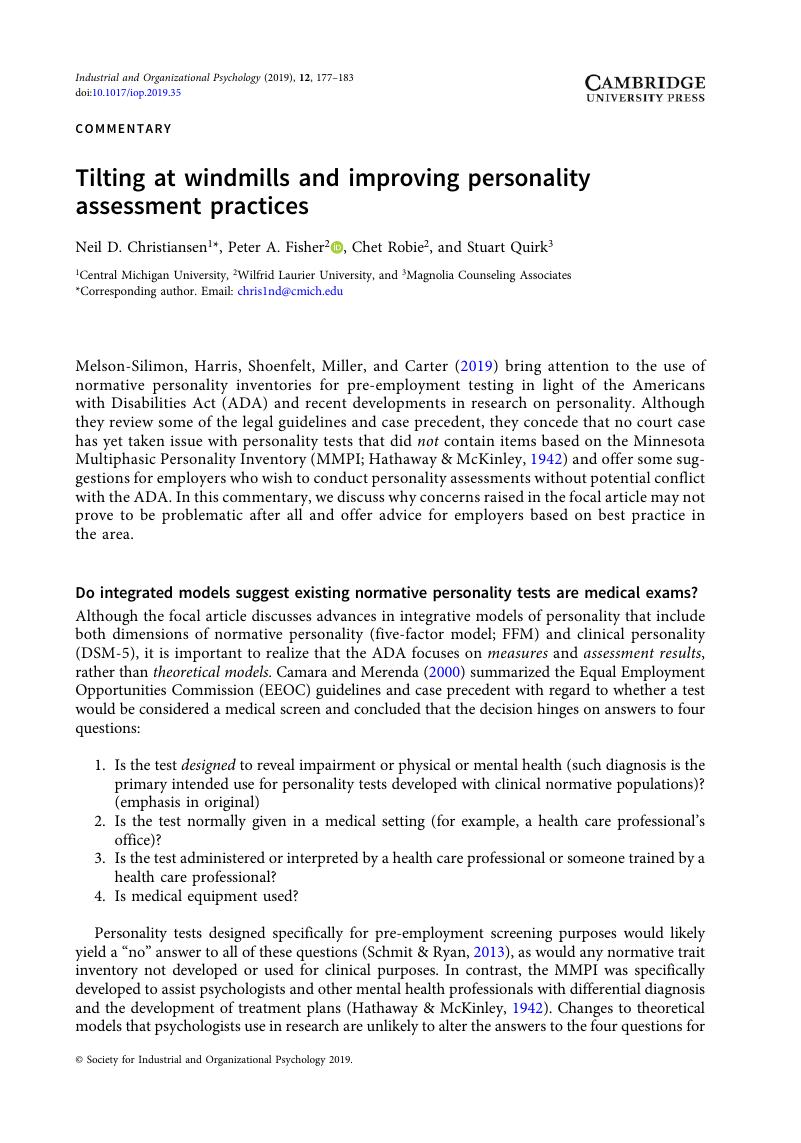No CrossRef data available.
Article contents
Tilting at windmills and improving personality assessment practices
Published online by Cambridge University Press: 01 August 2019
Abstract
An abstract is not available for this content so a preview has been provided. Please use the Get access link above for information on how to access this content.

- Type
- Commentaries
- Information
- Copyright
- © Society for Industrial and Organizational Psychology 2019
References
Butcher, J. N., Dahlstrom, W. G., Graham, J. R., Tellegen, A., & Kaemmer, B. (1989). Minnesota Multiphasic Personality Inventory—2: Manual for administration and scoring. Minneapolis, MN: University of Minnesota Press.Google Scholar
Camara, W. J., & Merenda, P. F. (2000). Using personality tests in preemployment screening: Issues raised in Soroka v. Dayton Hudson Corporation
. Psychology, Public Policy, and Law, 6(4), 1164–1186. doi: 10.1037/1076-8971.6.4.1164
CrossRefGoogle Scholar
Carter, N. T., Guan, L., Maples, J. L., Williamson, R. L., & Miller, J. D. (2016). The downsides of extreme conscientiousness for psychological well-being: The role of obsessive compulsive tendencies. Journal of Personality, 84, 510–522. doi: 10.1111/jopy.12177
CrossRefGoogle ScholarPubMed
Christiansen, N. D., Tett, R., & Robie, C. (2011, May). Problems and pitfalls in organizational uses of personality inventories. Paper presented at the European Congress of Work and Organizational Psychology, Maastricht, Netherlands.Google Scholar
Costa, P. T. Jr., & McCrae, R. R. (1992). Revised NEO Personality Inventory (NEO-PI–R) and NEO Five-Factor Inventory (NEO-FFI) professional manual. Odessa, FL: Psychological Assessment Resources.Google Scholar
Fowler, J. C., Patriquin, M. A., Madan, A., Allen, J. G., Frueh, B. C., & Oldham, J. M. (2017). Incremental validity of the PID-5 in relation to the five factor model and traditional polythetic personality criteria of the DSM-5: DSM-5 personality trait domains. International Journal of Methods in Psychiatric Research, 26(2), e1526. doi: 10.1002/mpr.1526
CrossRefGoogle Scholar
Furnham, A., Richards, S. C., & Paulhus, D. L. (2013). The dark triad of personality: A 10 year review. Social and Personality Psychology Compass, 7, 199–216. doi: 10.1111/spc3.12018
CrossRefGoogle Scholar
Gore, W. L. (2013). The DSM-5 dimensional trait model and the five factor model. Theses and Dissertations—Psychology, 12. https://uknowledge.uky.edu/psychology_etds/12
Google Scholar
Hathaway, S. R., & McKinley, J. C. (1942). Manual for the Minnesota Multiphasic Personality Inventory. Minneapolis, MN: University of Minnesota Press.Google Scholar
Helle, A. C., Trull, T. J., Widiger, T. A., & Mullins-Sweatt, S. N. (2017). Utilizing interview and self-report assessment of the five-factor model to examine convergence with the alternative model for personality disorders. Personality Disorders: Theory, Research, and Treatment, 8(3), 247–254. doi: 10.1037/per0000174
CrossRefGoogle ScholarPubMed
Hogan, R., & Hogan, J. (2001). Assessing leadership: A view from the dark side. International Journal of Selection and Assessment, 9, 40–51. doi: 10.1111/1468-2389.00162
CrossRefGoogle Scholar
Hunthausen, J. M., Truxillo, D. M., Bauer, T. N., & Hammer, L. B. (2003). A field study of frame-of-reference effects on personality test validity. Journal of Applied Psychology, 88, 545–551. doi:10.1037/0021-9010.88.3.545
CrossRefGoogle ScholarPubMed
Kajonius, P. J. (2017). The Short Personality Inventory for DSM-5 and its conjoined structure with the common five-factor model. International Journal of Testing, 17(4), 372–384. doi: 10.1080/15305058.2017.1309421
CrossRefGoogle Scholar
Melson-Silimon, A., Harris, A. M., Shoenfelt, E. L., Miller, J. D., & Carter, N. T. (2019). Personality testing and the Americans with Disabilities Act: Cause for concern as normal and abnormal personality models are integrated. Industrial and Organizational Psychology: Perspectives on Science and Practice, 12(2), 119–132.CrossRefGoogle Scholar
O’Neill, T. A., Goffin, R. D., & Rothstein, M. G. (2013). Personality and the need for personality-oriented work analysis. In Christiansen, N. & Tett, R. P. (Eds.), Handbook of personality at work (pp. 226–253). New York, NY: Routledge.Google Scholar
Quirk, S. W., Christiansen, N. D., Wagner, S. H., & McNulty, J. (2003). On the usefulness of measures of normal personality for clinical assessment: Evidence of the incremental validity of the Revised NEO Personality Inventory. Psychological Assessment, 15(3), 311–325. doi: 10.1037/1040-3590.15.3.311
CrossRefGoogle ScholarPubMed
Pocnet, C., Antonietti, J.-P., Handschin, P., Massoudi, K., & Rossier, J. (2018). The many faces of personality: The DSM-5 dimensional and categorical models and the five-factor model. Personality and Individual Differences, 121, 11–18. doi: 10.1016/j.paid.2017.09.005
CrossRefGoogle Scholar
Robie, C., Risavy, S. D., Holtrop, D., & Born, M. P. (2017). Fully contextualized, frequency-based personality measurement: A replication and extension. Journal of Research in Personality, 70, 56–65. doi: 10.1016/j.jrp.2017.05.005
CrossRefGoogle Scholar
Saulsman, L. M. & Page, A. C. (2004). The Five-Factor Model and personality disorder empirical literature. Clinical Psychology Review, 23(8), 1055–1085. doi: 10.1016/j.cpr.2002.09.001
Google ScholarPubMed
Schmidt, F. L., & Hunter, J. E. (2015). Methods of meta-analysis: Correcting error and bias in research findings (3rd ed.). Los Angeles, CA: Sage.CrossRefGoogle Scholar
Schmit, M. J., & Ryan, A. M. (2013). Legal issues in personality testing. In Christiansen, N. D. & Tett, R. P. (Eds.), Handbook of personality at work (pp. 525–542). New York, NY: Routledge.Google Scholar
Simpson, D. A., Christiansen, N. D., Dawson, K. (2017, April). Occupational differences in the validity of narrow personality traits. Paper presented in J. Johnson (Ed.), Don’t take quotes or personality assessment validities out of context. Symposium presented at the 32nd Annual Conference of the Society for Industrial and Organizational Psychology, Orlando, FL.Google Scholar
Sleep, C. E., Hyatt, C. S., Lamkin, J., Maples-Keller, J. L., & Miller, J. D. (2018). Examining the relations among the DSM-5 alternative model of personality, the five-factor model, and externalizing and internalizing behavior. Personality Disorders: Theory, Research, and Treatment, 9(4), 379–384. doi: 10.1037/per0000240
CrossRefGoogle ScholarPubMed
Society for Industrial and Organizational Psychology, Inc. (2018). Principles for the validation and use of personnel selection n procedures (5th ed.). Arlington Heights, IL: Author. https://www.apa.org/ed/accreditation/about/policies/personnel-selection-procedures.pdf
Google Scholar
Watson, D., Stasik, S. M., Ro, E., & Clark, L. A. (2013). Integrating normal and pathological personality: Relating the DSM-5 trait-dimensional model to general traits of personality. Assessment, 20(3), 312–326. doi: 10.1177/1073191113485810
CrossRefGoogle ScholarPubMed


